All the Answers
Well-known member
Second general strike against Milei: 64% of the 44 measures of force called by the CGT since 1983 were against non-Peronist governments - Infobae

Source:
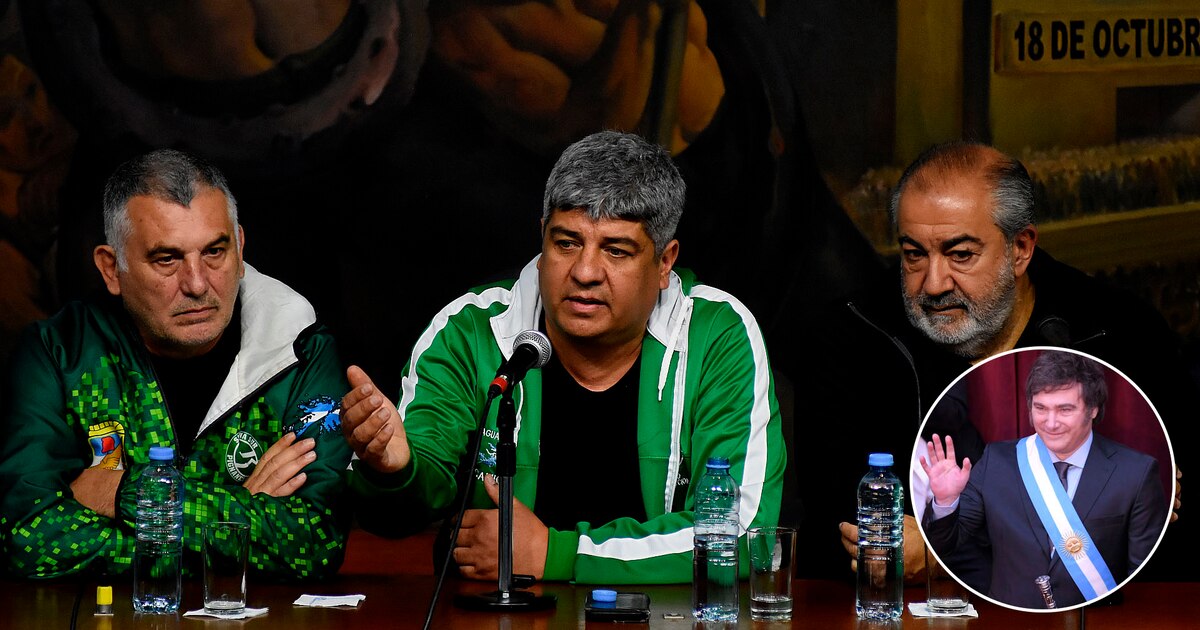
Segundo paro general contra Milei: el 64% de las 44 medidas de fuerza convocadas por la CGT desde 1983 fueron contra gobiernos no peronistas
El Gobierno libertario enfrenta la nueva protesta a 150 días de haber asumido. El ranking de cuántos reclamos de este tipo a nivel nacional tuvieron los distintos presidentes desde el retorno democrático
May 08, 2024
The libertarian government faces the new protest 150 days after taking office. The ranking of how many complaints of this type at the national level the different presidents have had since the democratic return
By Mariel Fitz Patrick
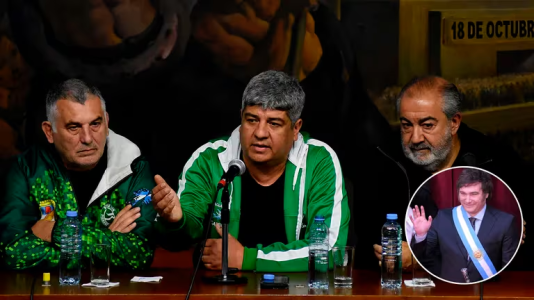
On May 1st the CGT ratified its general strike tomorrow, Thursday
With the bridges of dialogue broken with the General Confederation of Labor (CGT) and support in public opinion that exceeds 50% despite the depth of the adjustment , Javier Milei tomorrow faces his second general strike called by the labor union. It will take place 150 days - 4 months and 28 days - after his presidential inauguration . It is the 44th national force measure in the little more than four decades since the democratic return, at a rate of little more than one strike per government .
The strike and its scope will be a struggle between the Government and the unions with the aim of not only making visible their rejection of the adjustment plan that the libertarian is carrying out, but also using it as an element of pressure on the Senate to make the strike fail. Base Law promoted by the Government Especially on the Peronist and Kirchnerist legislators, with whom they have greater ideological affinity, but who also respond to the interests of their governors in need of resources. The official project that obtained half a sanction in the Lower House and began to be discussed this week in the Senate , includes a labor reform that resists unionism, despite the fact that it is a watered down version with respect to the original text.
Among the threats made by union members to the representatives in the Upper House, the one made yesterday by the head of the Aeronautical Personnel Association (APA), Edgardo LLanos, stood out . Akin to Kirchnerism, he called to “shock” each of the senators who vote in favor of the law when they board an Aerolíneas Argentinas plane , one of the companies included as “subject to privatization” in the Bases Law.
This second national strike against Milei will take place 105 days after the first one carried out by the CGT on January 24 , which had taken place just 44 days after the libertarian's arrival at the Casa Rosada , with a strong speech against the "caste" , in which he included union leaders. That first measure by the labor union broke the record of having been called in the shortest period since the presidential inauguration of a leader.
From the Casa Rosada, they recalled today that, in the five months that he has been in government, Milei also faced two other bus strikes, two of teachers, one of trains and another of aeronautical workers, in addition to "100 marches."
Milei shares with Fernando De la Rúa and Eduardo Duhalde the podium of having the shortest interval between the first general strike and the second. According to a work by the School of Government of the Austral University , Duhalde suffered his second measure of force just 7 days after the first, while De la Rúa had it 70 days after his first national strike. In the historical comparison, Raúl Alfonsín - who suffered a record 13 general strikes by the CGT during his administration - faced his second measure of force 261 days after the first.
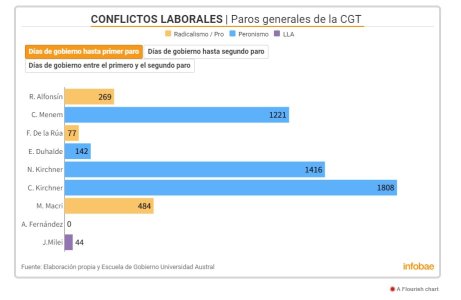
The two national measures of force of the labor union against the Milei government, in five months of administration, are added to the 26 called by the CGT against the three non-Peronist presidents who governed from the democratic return until December 10: Alfonsín , De la Rúa , and Mauricio Macri . In total, the 28 strikes - including tomorrow's - in 12 years of government , represent 64% of the 44 carried out by the CGT . An average of 7 general strikes per government.
On the other hand, the five Peronist leaders who spent a total of 28 years in the Casa Rosada since 1983 faced 16 general strikes (36%), at a ratio of 2 national strikes per administration.
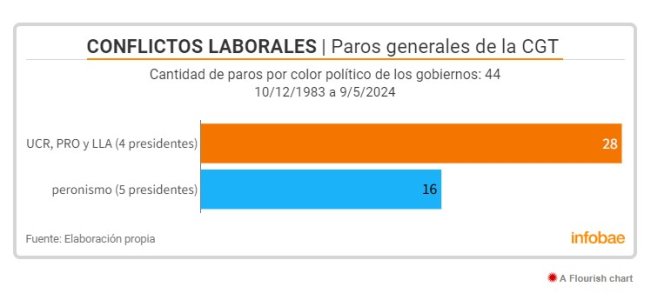
The average number of days until the first force measure of this type called by the Cegetista central office was carried out also shows a notable disparity between the Peronist presidents (1,209 days) and the non-Peronist presidents until last December (275 days) , according to a report. from the School of Government of the Austral University. With the first strike carried out against Milei in January, that average dropped from 275 to 218 days .
“From objective data, the union protest begins to resemble how unionism behaved against Fernando de la Rúa. The second strike was carried out 147 days after his administration began, that is, more or less during the same period of government as Milei. But from the context, it seems not to be comparable, because Milei retains popular support and unionism does not seem to be as strong as it was at that time," analyzed Marcelo Bermolén , director of the Institutional Quality Observatory (OCI) of that study house. before Infobae .
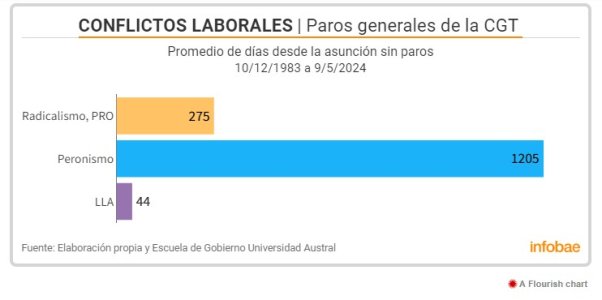
“This second strike is going to be stronger, more than anything, due to the accession of transportation and services . People are going to be captured by the measure of force. These days, Pablo Moyano was heard saying that the first strike in January had been a cessation of activities, in some way recognizing that it had been too fast and was not successful,” added this professor from the Austral School of Government. . The CGT has already announced that it is confident that this strike will be “ forceful ”, and the Government itself admits - quietly - something similar.
“Unionism, inspired a little by the massive university march on April 23 and relying on the piquetero muscle of winning the streets, will seek to make a show of force . Not only in the face of the economic situation, which is serious and is generating greater support than in the first strike, but more than anything to put pressure on the Senate so that the Base Law falls or, at least, is modified and has to return to the Chamber of Deputies , where it should be ratified by two-thirds of the votes, something difficult to achieve. Therefore, the threats to the senators that we heard from the union members,” said Bermolén.
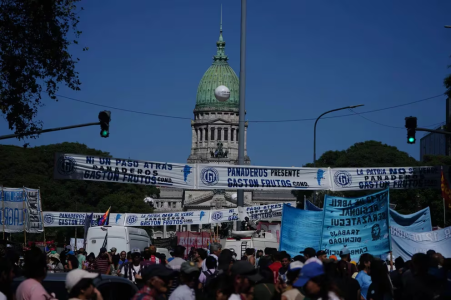
Mobilization on the day of the first general strike against Milei, last January 24 (Franco Fafasuli)
And in that sense, he considered that “reality ended up proving right” to unionism and its pressure actions, since “it obtained precautionary measures from Justice” and the annulment of the DNU in the Senate. “They had already managed to remove Banco Nación from the privatizable companies included in the Bases Law, and managed to reduce the labor reform from 60 articles to 15. So, when the high-sounding declarations of unionism are analyzed and the facts are compared, it seems that they achieved some degree of effectiveness with threats and pressure . This Thursday's strike is part of this framework.”
The ranking of strikes by president
Since the democratic return, the president who faced the greatest number of CGT strikes was Alfonsín , a total of 13 in his five and a half years in office, which culminated in the midst of hyperinflation and a strong economic deterioration. The first of that record took place in the eighth month of his mandate, on September 3, 1984, 269 days after taking office. The last one, 10 months before handing over the band in advance to Carlos Menem . All were promoted by the then head of the labor union, Saúl Ubaldini , who led a tough opposition to the radical president, based on his frustrated attempt to democratize the unions with the so-called “Mucci Law”, by the first Minister of Labor of Alfonsinism. , Antonio Mucci . On average, he suffered a strike every 157 days of his government.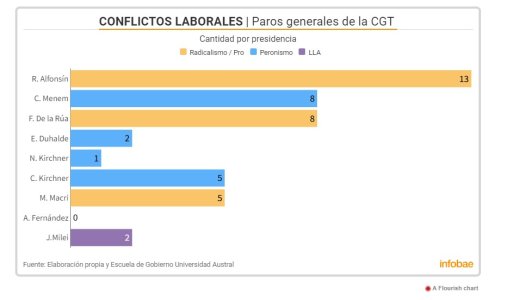
At the other extreme, Alberto Fernández took the record of being the first Peronist president to complete his 1,460-day mandate without general strikes , despite his political weakness and the critical economic situation that his government caused.
In the ranking of CGT strikes, Alfonsín is followed by De la Rúa with 8 measures of force in the two years that his mandate lasted. The radical had to leave power in the midst of the acute economic and social crisis of December 2001. The first measure of strength was in the third month of his government, after 77 days. The former president also faced strong union opposition for his economic measures and the labor reform project that ended with the scandal of the so-called “Banelco Law”, which involved the payment of bribes in the Senate to seek its approval.
Menem also faced 8 general strikes and became the Peronist president with the most national protests of this type to his name, although they took place throughout the 10 years he was in power. Four strikes took place in his first term of 6 and a half years, and the other 4, in his second presidency of 4 years. However, the Rioja president managed to govern 1,221 days without forceful measures from the union centers, which took more than three years and four months to confront him with a strike. That first strike called by the CGT during Menemism was on November 9, 1992, against its economic policy.
Cristina Kirchner and Macri , paradoxically, suffered the same number of strikes organized by the CGT: five each . But the former president finished her first term unscathed. The ones she faced were all in her second term, starting with her breakup with the head of Camioneros, Hugo Moyano , promoter of those forceful measures, and called by the CGT Azopardo, the CGT Azul y Blanca and the Autonomous CTA. The first - 1,808 days after her arrival at the Casa Rosada - was on November 20, 2012, in rejection of the Income Tax and demanding an increase in pensions and allowances. The former president holds the record for having the longest interval until a second general strike of a president, which took place just 2,313 days after the inauguration of her first term of government (6 years and four months later).
In the case of the PRO leader, a year and almost four months passed from his inauguration until he faced the first general strike of the five that the labor union would carry out. Thus, Macri was the only president of a non-Peronist government who achieved this impasse of more than a year on the part of the CGT.
In the ranking of general strikes by presidency, Eduardo Duhalde follows with two measures of this type in the year and 5 months that he was in the Casa Rosada, to which he was elected by a Legislative Assembly, after the resignation of De la Rúa. and the crisis of 2001.
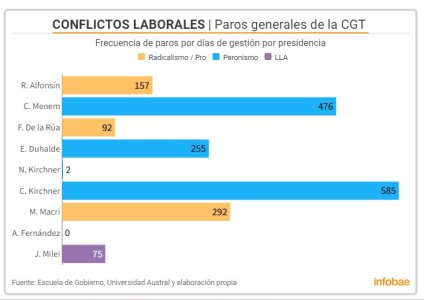
Thus, while Macri had 5 strikes in 1,461 days of government (on average, one strike every 292 days), Duhalde had 2 in 509 days (one strike every 292 days of administration) and became the Peronist president with the worst average, of according to data collected by the School of Government of the Austral University. However, all Peronist governments had fewer strikes in proportion to the days in government than non-Peronist governments.
Néstor Kirchner faced only one CGT strike at the end of his mandate, on April 9, 2007. But it was not against his economic policy, marked by the economic growth of the first years, but against the death of a Neuquén teacher. The murder of Carlos Fuentealba in a claim against the provincial governor managed to unite the two union centers facing each other at that time, the CGT of Moyano and the CTA of Hugo Yasky , something that had not happened since the Menem era.
When the first strike against Milei had taken place, Bermolén warned about “the destabilizing factor that causes union hostility, marked by the early call for general strikes,” as well as the amount carried out against non-Peronist presidents. “To the point that two of the three predecessors of that trend who preceded Javier Milei in office did not finish their terms,” he recalled.
“Beyond the responsibilities that non-Peronist leaders have when it comes to governing and how difficult it is to have Justicialism in the opposition role, it is evident that union activity materialized in more frequent and more severe strikes for the Governments of a different nature explain a portion of the historical difficulties in governing that non-Peronist presidents have encountered. In fact, Mauricio was the only one who was able to complete his mandate, after the failed efforts of De la Rúa and Alfonsín,” added this specialist in institutional quality and electoral transparency of Austral.
Views: Daniela Czibener

